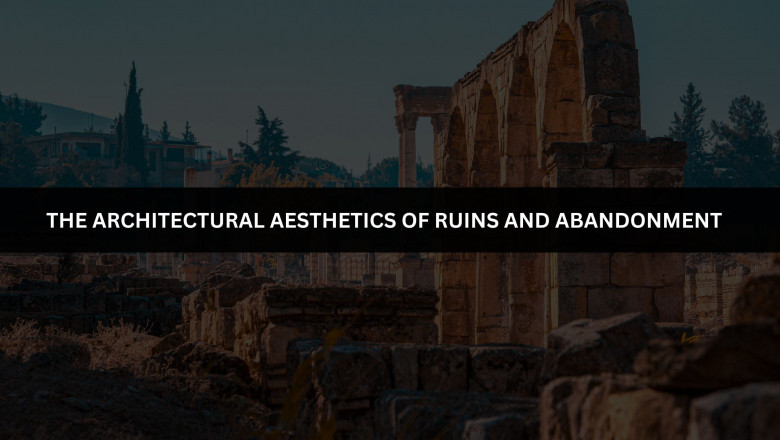views
Ruins have a certain and alluring beauty that conveys silent tales of time, culture, and history. Artistic inspiration, mystery, and nostalgia are all evoked by the architectural beauty of abandoned buildings. Ancient temples, abandoned palaces, or dilapidated industrial structures are examples of places that defy accepted design ideas and provide an unvarnished, unadulterated look at the development of architecture. In Varanasi, where history and modernity coexist, studying ruins is important for architects because it helps them understand how time and nature influence design in addition to preservation.
The Beauty in Decay
Ruins are living canvases molded by time, weather, and human activity; they are more than simply artifacts from the past. No modern design can match the naturalistic look created by crumbling facades, overgrown plants, and exposed foundations. A lyrical view of architecture is provided by the harmony between order and disorder, structure and ruin.
This idea has impacted modern designers and architects, who frequently find inspiration in the faults, asymmetries, and textures of deserted areas. By fusing ancient relics with contemporary utility, many restoration efforts seek to preserve this unvarnished aesthetic. This idea is frequently adopted by Varanasi architects who work on heritage sites, conserving old buildings while updating them for modern purposes.
The Cultural and Historical Significance of Ruins
Because they exhibit the building methods, materials, and architectural styles of their era, ruins provide physical connections to the past. Abandoned temples, castles, and fortresses all around the world provide a window into the artistry and craftsmanship of earlier societies. Ruins are not just abandoned areas but also cherished heritage sites in places like Varanasi, where antique buildings from the past mingle with new construction.
Ruins of buildings are also essential to cultural identity. They stand for time passing, adaptability, and resiliency. Architects can better grasp historic building techniques, sustainability principles, and the effects of climate change on materials by conserving and researching these structures. The difficulty for a Varanasi architect is to restore these areas without losing their historic character.
Nature’s Role in Architectural Abandonment
An ethereal union of the natural and manmade worlds is created when abandoned structures progressively blend in with the surroundings. Ruins are transformed into stunning sceneries by ivy-covered walls, moss-filled hallways, and trees sprouting through shattered windows. This phenomena reinforces the idea of impermanence in building by demonstrating how nature can reclaim man-made constructions.
The symbiotic interplay between development and decay serves as an inspiration for many contemporary architects who use these organic features in their projects. Adaptive reuse, which involves repurposing abandoned structures instead of demolishing them, has becoming more popular all around the world. For instance, an architect in Varanasi might renovate an ancient haveli while incorporating green areas and natural ventilation, maintaining the building's historical character but adapting it for modern use.
Philosophical and Emotional Impact of Abandoned Spaces
A range of feelings, including nostalgia, wonder, melancholy, and curiosity, are evoked by ruins. They serve as a reminder of the fleeting character of civilizations and the unavoidable effects of time. In order to capture this emotional depth and transform it into artistic expressions, a lot of photographers, painters, and architects investigate abandoned areas.
The idea of perfection is questioned by these buildings from an architectural standpoint. They encourage designers to reconsider traditional aesthetics by celebrating irregularity, incompleteness, and imperfection. This way of thinking is consistent with Japanese architecture's Wabi-Sabi idea, which finds beauty in impermanence and imperfection.
The psychological and philosophical significance of ruins necessitates a careful approach from architects working on restoration initiatives. Instead of erasing age indications, the intention is to embrace them and let history coexist with contemporary initiatives.
The Future of Ruins: Preservation or Reinvention?
Many ruins are under danger of being demolished as urbanization grows. However, preservation and adaptive reuse activities have expanded as a result of a growing appreciation for historic buildings. Finding a balance between preserving authenticity and guaranteeing structural stability is the difficult part.
Innovative approaches to incorporating ruins into modern environments are being investigated by architects and urban planners. Some proposals preserve the original charm of abandoned buildings while converting them into museums, cultural hubs, or boutique hotels. Such programs guarantee that historic architecture is accessible and relevant in places like Varanasi, where modernity and heritage coexist.
An architect working on conservation projects in Varanasi is aware of the importance of these buildings, not only as artifacts but also as sources of inspiration for the future. Architects can design environments that respect history while meeting contemporary demands by embracing the aesthetic and historical significance of ruins.
Timeless Lessons from Ruins
We learn from ruins that architecture is never really completed; it changes, deteriorates, and evolves throughout time. They serve as a reminder that structures are dynamic beings influenced by human interaction, history, and the natural world. Architects are prompted to reconsider their designs' long-term effects, material selections, and durability by studying ruins.
The aesthetics of abandonment provide important insights in a world that is becoming more and more concerned with sustainability and adaptive reuse. Architects may create designs that are not only useful but also have a strong historical and cultural foundation by taking inspiration from these abandoned areas.














Comments
0 comment